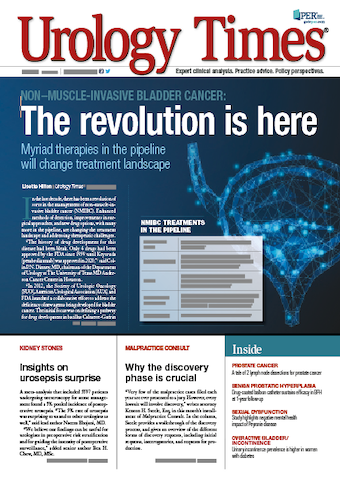Publication
Article
Urology Times Journal
Study highlights negative mental health impact of Peyronie disease
Author(s):
Depression is common among individuals with Peyronie disease (PD), according to findings of a retrospective study.
The study, which was reported in an article published online by The Journal of Sexual Medicine, aimed to identify factors that could predict depression among individuals seeking evaluation for early PD. Analyses comparing depressed and nondepressed cohorts categorized by scores on the validated Center for Epidemiologic Studies Depression Scale (CES-D) found no statistically significant differences between the 2 groups in any of the demographic-, bother-, or curve-related characteristics that were assessed as potential predictors. Notably, however, the depressed cohort represented 27% of the 408 study participants.
“There have been just 2 previous reports investigating the direct impact of PD on mental health, and they only briefly explored potential predictors of mental illness in this patient population. Given the limited data and the importance of this association, we undertook this study to determine if there were any characteristics that might help clinicians identify men with PD who are [experiencing] depression,” said Nahid Punjani, MD, MPH, first author of the published report, in an interview with Urology Times®.
“Although we did not identify any demographic-, bother-, or curve-related risk factors, we hope our study will lead urologists to acknowledge there is a high prevalence of depression in men with PD and to initiate an appropriate referral to a mental health care professional when indicated,” added Punjani, who is a fellow in male sexual medicine at Memorial Sloan Kettering Cancer Center and a fellow in reproductive medicine and instructor of urology at Weill Cornell Medical College in New York City, New York.
The investigators retrospectively reviewed prospectively collected data from patients with documented PD seen by a single provider, John P. Mulhall, MD, director of the Male Sexual and Reproductive Medicine Program at Memorial Sloan Kettering Cancer Center.
To be eligible for inclusion, participants needed to have undergone a curvature assessment upon intracavernosal injection at the time of duplex ultrasound and have completed 3 questionnaires that all patients with PD are asked to fill out at initial presentation: the Self-Esteem and Relationship (SEAR) questionnaire, which assesses the psychosocial impact of erectile dysfunction (ED); the Peyronie’s Disease Questionnaire (PDQ), which assesses the psychosexual consequences of PD; and the CES-D, which is used to screen for depression/depressive disorder. Patients with a CES-D score of 16 or higher were categorized as having clinically meaningful depression and comprised the depressed group.
“Dr Mulhall uses the CES-D as part of a highly structured, standardized intake for patients seeking evaluation for PD. Urologists, however, may employ any validated depression screening questionnaire to identify men with PD who may be depressed. They might also consider closely collaborating with a mental health professional at their institution,” Punjani said.
The 408 participants had a mean age of approximately 56.5 years and mean duration of PD of approximately 20 months. Features that differed significantly between the depressed and nondepressed groups included being partnered (83.9% vs 73.6%, respectively), having a history of depression (26% vs 11%, respectively), and mean degree of curvature (38° vs 33°, respectively). The latter difference, however, was not considered clinically meaningful, and the percentage of participants with a complex deformity was similar in the 2 groups. The depressed group also had significantly worse PDQ and SEAR scores than the nondepressed group.
Several factors compared among groups
Risk factors for depression were examined through logistic regression modeling. The multivariable models considered age, partner status, duration of PD, history of depression, complexity of deformity, PDQ domain scores, total SEAR score, and ED as potential predictors. Only the total SEAR score was independently associated with depression—having a higher (more favorable) SEAR score was protective against depression. The investigators noted that the SEAR questionnaire has not been validated in the PD population.
“Moving forward with research to understand the psychological and emotional impacts of PD, we hope to explore issues related to partner distress in this patient population,” Punjani said.
Reference
1. Punjani N, Nascimento B, Salter C, et al. Predictors of depression in men with Peyronie’s disease seeking evaluation. J Sex Med. Published online March 9, 2021. doi:10.1016/j.jsxm.2021.02.002































